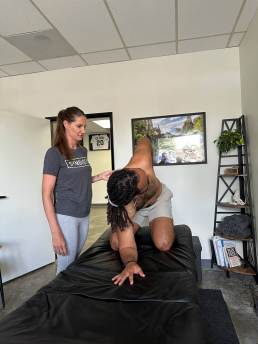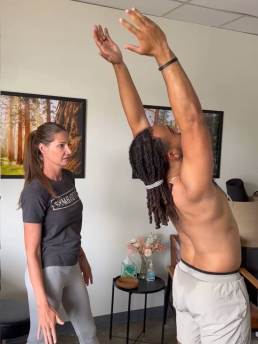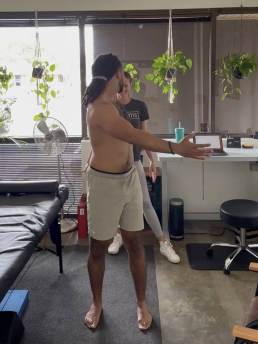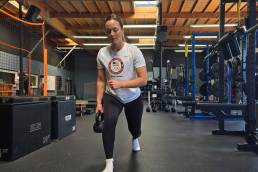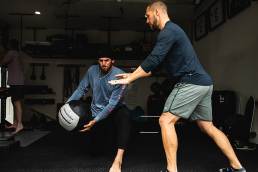As a physical therapist deeply invested in sports rehabilitation and injury prevention, I’ve witnessed firsthand the critical role that spinal mobility plays in maintaining athletes’ health and performance. In the dynamic world of sports, where movement is multidimensional and demands on the body are varied, possessing adequate spinal mobility across all three planes of movement—sagittal, frontal, and transverse—is not just beneficial but essential for preventing injuries and optimizing athletic capabilities.
Understanding Spinal Mobility
The spine serves as the central axis of the body, providing structural support and facilitating a wide range of movements crucial for athletic performance. Here’s a breakdown of the three planes of spinal movement and their significance:
Sagittal Plane
Movement forward and backward, such as bending forward (flexion) and backward (extension).
Frontal Plane
Movement side to side, such as bending sideways (lateral flexion).
Transverse Plane
Rotation around the axis of the spine, enabling twisting movements.
Why Spinal Mobility Matters for Injury Prevention
Enhanced Movement Efficiency
Optimal spinal mobility allows athletes to move more efficiently and effectively through various movements required in their sport. For instance, baseball pitchers need adequate thoracic spine rotation (transverse plane mobility) to generate power and accuracy in their throws, while gymnasts require strong spinal extension (sagittal plane mobility) for backflips and other acrobatic maneuvers. When the spine moves freely in all planes, athletes can perform complex movements with greater ease and precision, reducing the risk of compensatory movements that can lead to overuse injuries.
Distribution of Forces
During sports activities, the spine acts as a conduit for force transmission between the upper and lower body. Proper spinal mobility ensures that forces generated during movements—such as throwing, jumping, or pivoting—are distributed evenly throughout the spine and peripheral joints. Without adequate mobility, certain segments of the spine may become overloaded, increasing the risk of stress fractures, muscle strains, or joint sprains.
Maintenance of Postural Alignment
A mobile spine supports optimal postural alignment during both dynamic movements and static positions. Poor spinal mobility can lead to postural deviations, such as excessive thoracic kyphosis (rounding of the upper back) or lumbar hyperlordosis (exaggerated inward curve of the lower back), which can predispose athletes to chronic musculoskeletal imbalances and injuries over time.
Practical Applications in Injury Prevention Strategies
As a physical therapist, I incorporate specific strategies to promote and maintain spinal mobility among athletes:
Comprehensive Assessment
Conducting thorough musculoskeletal assessments to identify any restrictions or asymmetries in spinal mobility across all planes of movement.
Targeted Mobility Exercises: Prescribing individualized stretching and mobilization exercises that address specific limitations in spinal mobility. This may include exercises like cat-cow stretches for sagittal plane mobility, side bends for frontal plane mobility, and rotational stretches for transverse plane mobility.
Functional Movement Training
Integrating functional exercises that mimic sport-specific movements while emphasizing proper spinal alignment and mobility. For example, incorporating medicine ball rotational throws for baseball players to enhance thoracic spine rotation in the transverse plane.
Core Stability Training
Emphasizing the importance of core stability in supporting spinal mobility. Strengthening the deep core muscles (e.g., transversus abdominis, multifidus) helps maintain spinal alignment and control during dynamic movements.
Real-World Benefits for Athletes
Investing in spinal mobility brings numerous benefits to athletes:
Reduced Injury Risk
By maintaining optimal spinal mobility, athletes can mitigate the risk of common musculoskeletal injuries associated with repetitive sports movements.
Improved Performance
Enhanced spinal mobility translates to improved movement efficiency, agility, and overall athletic performance.
Longevity in Sports
Promoting spinal health and mobility supports athletes in sustaining long-term participation and enjoyment in their chosen sport without being sidelined by preventable injuries.
Conclusion: Empowering Athletes through Spinal Mobility
In conclusion, prioritizing gross spinal mobility in all three planes of movement is integral to the overall health, performance, and longevity of athletes. As a physical therapist, I advocate for a holistic approach to injury prevention that includes assessing, enhancing, and maintaining spinal mobility through targeted interventions and personalized rehabilitation programs.
By fostering a mobile spine, athletes can unlock their full potential, minimize injury setbacks, and continue to excel in their athletic endeavors with confidence and resilience. Embracing the importance of spinal mobility is not just about injury prevention—it’s about empowering athletes to thrive and achieve their goals on and off the field.
Symbiotic Physical Therapy
Symbiotic Physical Therapy works alongside Symbiotic Training Center to offer a variety of manual treatment options and an emphasis on maximizing the body’s self-healing mechanisms. Examples of manual therapy include: Deep tissue massage, cupping, scraping, taping, joint mobilization, Functional Manual Reaction (FMR), manual lymphatic stimulation, Active Release Technique (ART), and Proprioceptive Neuromuscular Facilitation (PNF).
Our physical therapy services are open to everyone, whether you are an athlete coming to train at the facility, or just trying to better your health. For those interested in sport-specific training, we provide full body athlete assessments so that the training staff can create individualized training programs that are unique to your needs, help improve your athletic performance, and decrease the chance of injury.
My Journey to Team USA: How I Made it
Professional softball player Ali Aguilar shares essential advice for young athletes aspiring to represent Team USA.
Things I wish I knew when I was in high school
Joe Musgrove: "If you’re dreaming of achieving success in your sport—or in any field—remember that the journey is as important as the destination."
Preparing for College Softball: Perspective on Travel Ball and What Needs to Change
There are a number of aspects of travel softball that, although well-meaning, may not be preparing young athletes for the demands and realities of college softball.


